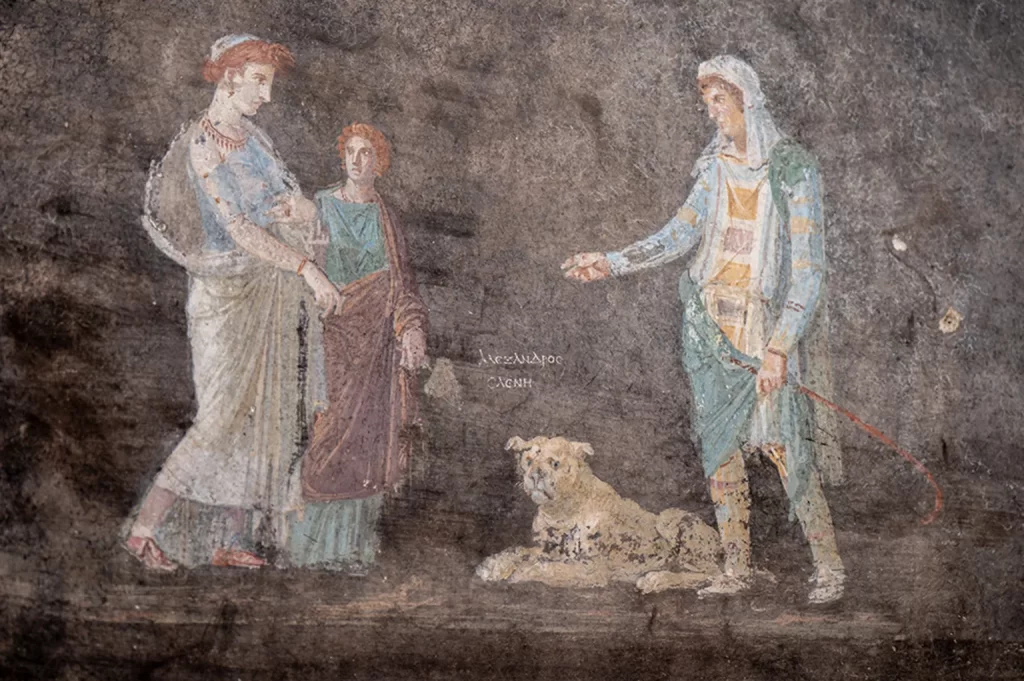Introduction
In a remarkable archaeological discovery, a team of researchers in Pompeii has unearthed a series of exceptionally preserved frescoes, shedding new light on the legendary tales of the Trojan War. These frescoes, found adorning the walls of a banquet hall within a residential and commercial block of the ancient city, offer vivid depictions of key figures and events from Greek mythology.
One striking painting portrays the god Apollo, wielding his iconic lyre, in a moment of attempted seduction of Cassandra, a figure gifted with foresight by the deity himself. Mythology recounts Apollo’s unsuccessful pursuit of Cassandra’s affection, leading to a curse that rendered her prophecies unbelievable. This curse, tragically, played a significant role in the unfolding of the Trojan War.

Mythology in Motion
The frescoes not only capture pivotal moments from the Trojan War saga but also evoke the timeless allure of Greek mythology. Among the scenes depicted is the infamous abduction of Helen of Troy by Paris, also known as Alexander. The complex narrative surrounding Helen’s departure from Sparta, whether by force or by her own volition, is a subject of enduring fascination.
Another captivating portrayal features Zeus, the king of the gods, assuming the guise of a swan to seduce Leda, the queen of Sparta and mother of Helen. This mythological motif, portraying divine intervention in mortal affairs, serves as a poignant precursor to the events that precipitated the Trojan War.

Aesthetic Marvels: The Third Style of Roman Wall Painting
The frescoes discovered in Pompeii’s banquet hall exhibit characteristics typical of the Third Style of Roman wall painting, prevalent from approximately 20 BCE to 60 CE. Distinguished by its emphasis on small, finely rendered figures set against monochromatic backgrounds, the Third Style creates an illusion of depth and dimensionality.
Intricate borders and ornamental elements adorn the periphery of the frescoes, enhancing their visual appeal and lending an air of sophistication to the overall composition. The use of dark backgrounds, rather than the vibrant hues typically associated with Pompeian wall paintings, serves a practical purpose, obscuring carbon residue left behind by lamps that once illuminated the space.

A Glimpse into Pompeian Life
The banquet hall in which these frescoes were discovered provides valuable insights into the social and cultural milieu of ancient Pompeii. As a hub of communal gatherings and conviviality, it served as a setting for post-sunset feasts illuminated by the flickering light of oil lamps.
Archaeological evidence suggests that the residential property to which the banquet hall belonged was undergoing renovations at the time of Mount Vesuvius’s eruption in 79 CE. The presence of construction materials beneath the archway of a staircase leading to the site’s first floor offers a tantalising glimpse into the architectural evolution of Pompeian dwellings.
Conclusion
The discovery of these exquisitely preserved frescoes not only enriches our understanding of Pompeii’s artistic heritage but also provides a window into the enduring allure of Greek mythology. As archaeologists continue to unravel the mysteries buried beneath the ash of Vesuvius, each new find serves as a testament to the resilience of Pompeii’s cultural legacy and the timeless appeal of the classical world.
Feature Image: The frescos depict Greek mythology: Paris kidnaps Helen which triggers the Trojan War | Courtesy: BBC/Tony Jolliffe
Yayoi Kusama Emerges as Top-Selling Contemporary Artist of 2023






